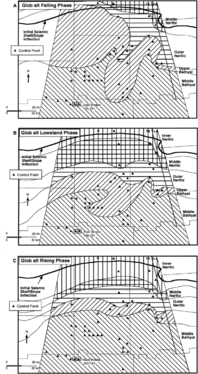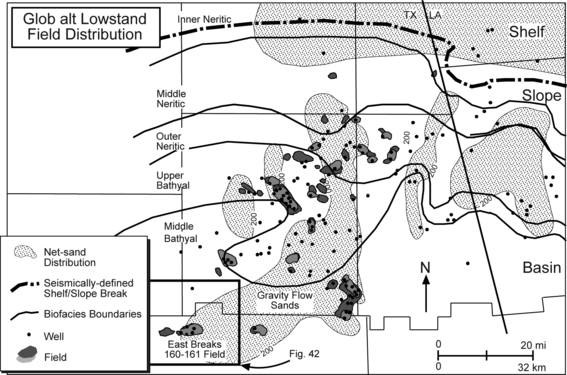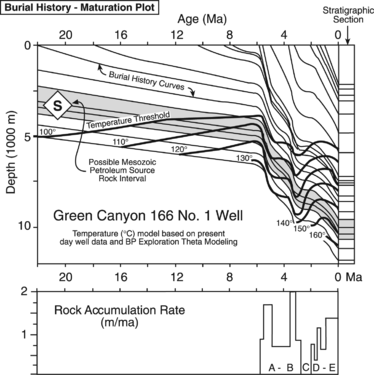Superimposed sea level cycles
| Exploring for Oil and Gas Traps | |

| |
| Series | Treatise in Petroleum Geology |
|---|---|
| Part | Critical elements of the petroleum system |
| Chapter | Sedimentary basin analysis |
| Author | John M. Armentrout |
| Link | Web page |
| Store | AAPG Store |
Cycle phase
Cycle phase is the position of relative sea level along a cycle curve at any moment in time. There are at least five or six orders of sea level cycles. Each order can be in phase or out of phase with the other orders. When two successive orders are in phase, i.e., fourth-order transgressions are in phase with third-order transgressions, the impact that each has on deposition or erosion is enhanced.[1] Understanding this phenomenon can help in stratigraphic prediction and lead to the discovery of new fields.
Superimposition of phases
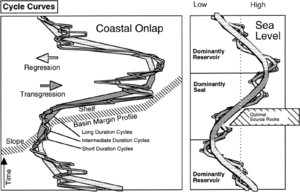
When each scale of cyclicity is convolved with or superimposed onto the next higher order, the patterns of transgression vs. regression either amplify or dampen the transgressions and regressions of the next higher order(s) of cyclicity. The right side of the following schematic illustrates cycle stacking of three orders of symmetrical cyclicity of short (narrow curve), intermediate, and long duration (wide curve), analogous to the fourth, third, and second orders of Haq et al.[2] Transgressive phases (darker shading) of the short-duration cycles are amplified when coincident with the transgressive phase of the intermediate-duration cycle—even more so if coincident with the transgressive phase of the long-duration cycle.
The same pattern of amplification occurs for coincident regressive cycle phases (lighter shading). When short-duration transgressive phases occur on the regressive phase of the intermediate cycle, the short-duration transgressive phase is dampened and will be even more so if it occurs during the long-duration regressive phase. Regressive phases are similarly dampened if they occur on long-duration transgressions.
The left side of Figure 1 shows the amplification of transgressive and regressive cyclicity when superimposed across a continental margin. Relative sea level rise and fall results in rapid transgressive or regressive deposition across a relatively low-gradient shelf area, slowed and vertically stacked if deposition occurs against a relatively steep gradient slope or basin margin. Regressive phases of siliciclastic deposition are likely to transport significant volumes of sand into the basin, depositing potential reservoir facies. Transgressive phases of siliciclastic deposition are likely to deposit regionally extensive muds, forming potential top seal for underlying regressive sands. During the dominantly transgressive phases of stacked long-to-short transgressive sequences, organic matter can become concentrated in marine muds, forming potential hydrocarbon source rocks.[3][4]
Depositional geometry of superimposed cycles
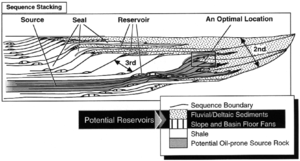
Figure 2 shows the depositional geometry of third-order cycles stacked into a second-order transgressive/regressive cycle. Each third-order cycle is represented by a depositional sequence composed of three phases (Figure 4-18). The lowstand phase may consist of basinal sand-prone mounds (basin-floor fans) and shelf-edge deltas. The transgressive phase is usually dominated by regional mudstones. The highstand most often consists of prograding fluvial and deltaic sediments forming broad coastal plains with potential sandstone reservoir facies.
In carbonate-prone depositional settings, the transgressive-to-highstand phases may be dominated by regionally extensive carbonate platforms. The mudstone-dominated transgressive deposits can provide potential hydrocarbon source rocks, especially in the third-order transgressive phases composited within the second-order transgressive phase. In contrast, the dominance of third-order regressive phases within the second-order regression brings more potential reservoir sand progressively further into the basin. Optimal hydrocarbon traps form where the regressive sandstones are in close proximity to organic-rich transgressive mudstones and are overlain by effective top seal.
Effect on reservoir deposition
Figure 4 Relationship between 23 fields in the High Island–East Breaks depocenter that produce from the Glob alt sandstones and the Glob alt sandstone 200-ft (60-m) isopach.
Figure 5 Rock accumulation rates for the Green Canyon 166 No. 1 well as a histogram (lower graph) and as a set of burial history curves (upper graph). After Piggott and Pulham;[8] courtesy Gulf Coast SEPM.
The lowstand phase of the Glob alt depositional sequence is sand prone (Figure 3) and produces hydrocarbons from at least 23 fields within the High Island–East Breaks depocenter (Figure 4). The sandstone reservoirs were deposited within slope valleys by gravity-flow processes.[6] The abundance of Glob alt sandstone is interpreted to be the consequence of a major fall in relative sea level. The falling sea level resulted in enhanced bypass of sand across the shelf and into the slope basins and deposition of a lowstand systems tract.
The Glob alt sequence mapped on Figure 3 represents the lowstand depositional phase of the Haq et al.[2]) third-order 3.7 cycle (Figure 4-25). Cycle 3.7 begins with the most significant relative fall in sea level of the Tejas B-3 supersequence after the second-order highstand (cycles 3.4 and 3.5). This significant fall in sea level resulted in transport of large volumes of sand from the paleo-Mississippi River system into the slope basins of the High Island and East Breaks areas of offshore Texas (Figures 3 and 5), depositing numerous potential reservoirs of gravity-flow sands during maximum amplification of falling sea level. Following lowstand deposition, relative rise in sea level cut off the sand supply and resulted in deposition of hemipelagic mudstones, forming a regional top seal to the Glob alt sandstones (Figures 3 and 5). The top seal is a condensed section that correlates laterally with the transgressive and early highstand systems tracts.
See also
- Sea level cycle phase
- Determining sea level cycle order
- Sea level cycle phase and systems tracts
- Systems tracts identification
- Systems tracts and trap types
- Identifying sea level cycle phase with biostratigraphy
- Biofacies and changing sea level
- Constructing age model charts
References
- ↑ Mitchum, R., M., Jr., Van Wagoner, J., C., 1990, High-frequency sequences and eustatic cycles in the Gulf of Mexico basin: Proceedings, Gulf Coast Section SEPM 11th Annual Research conference, p. 257–267.
- ↑ 2.0 2.1 2.2 Haq, B., Hardenbol, J., Vail, P., R., 1988, Mesozoic and Cenozoic chronostratigraphy and cycles of sea-level change: SEPM Special Publication 42, p. 71–108.
- ↑ Creaney, S., Passey, Q., R., 1993, Recurring patterns of total organic carbon and source rock quality within a sequence stratigraphic framework: AAPG Bulletin, vol. 77, p. 386–401.
- ↑ Herbin, J., P., Fernandez-Martinez, J., L., Geyssant, J., R., Albani, A., E., Deconinck, J., F., Proust, J., N., Colbeaux, J., P., Vidier, J., P., 1995, Sequence stratigraphy of source rocks applied to the study of the Kimmeridgian/Tithonian in the North-West European shelf (Dorset/UK; Yorkshire/UK; Boulonnais/France): Marine and Petroleum Geology, vol. 12, no. 2, p. 177–194., 10., 1016/0264-8172(95)92838-N
- ↑ Bartek, L., R., Vail, P., R., Anderson, J., B., Emmet, P., A., Wu, S., 1991, The effect of Cenozoic ice sheet fluctuations on the stratigraphic signature of the Neogene, in Cloetingh, S., ed., Long Term Sea Level Changes: Journal of Geophysical Research, vol. 96, 6753–6778.
- ↑ 6.0 6.1 Armentrout, J. M., 1991, Paleontological constraints on depositional modeling: examples of integration of biostratigraphy and seismic stratigraphy, Pliocene–Pleistocene, Gulf of Mexico, in Weimer, P. Link, M. H., eds., Seismic Facies and Sedimentary Processes of Submarine Fans and Turbidite Systems: New York, Springer-Verlag, p. 137–170.
- ↑ Armentrout, J. M., 1996, High-resolution sequence biostratigraphy: examples from the Gulf of Mexico Plio–Pleistocene, in J. Howell and J. Aiken, eds., High Resolution Sequence Stratigraphy: Innovations and Applications: The Geological Society of London Special Publication 104, p. 65–86.
- ↑ Piggott, N., and A. Pulham, 1993, Sedimentation rate as the control on hydrocarbon sourcing, generation, and migration in the deepwater Gulf of Mexico: Proceedings, Gulf Coast Section SEPM 14th Annual Research Conference, p. 179–191.
